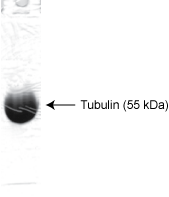Tubulin Protein (>99% Pure): Porcine Brain | T240
- SKU:
- T240-A | T240-B | T240-C | T240-D
- Availability:
- In Stock
Description
Product Uses Include
- IC50 & EC50 determinations for anti-tubulin ligands.
- Microtubule binding studies
- Tubulin monomer binding studies
- HDAC6 studies
- Microtubule activated kinesin ATPase assays
Material
Tubulin protein has been purified from porcine brain by an adaptation of the method of Shelanski et al. (1), Further purification to >99% purity was achieved by cation exchange chromatography. Tubulin is supplied as a white lyophilized powder.
Fully active for polymerization, this product is lyophilized with a patented technology for increased stability and longevity. T240 is stable for 1 year at 4°C desiccated. If your project requires the same batch of tubulin for consistent results, it is highly recommended that the item is purchased in bulk in order to save time and money. This product can be used as a substitute for our highly purified bovine tubulin products (Cat. # TL238, T238 and T237) and behaves in an identical fashion.
Purity
Purity is determined by scanning densitometry of proteins on SDS-PAGE gels. Samples are >99% pure

Figure 1: A 20 µg sample of T240 protein was separated by electrophoresis on a 10% SDS-PAGE gel and stained with Coomassie Blue. Protein quantitation was performed using the Precision Red Protein Assay Reagent (Cat. # ADV02).
Biological Activity
One unit of tubulin is defined as 5.0 mg of purified protein (as determined by the Precision Red Advanced Protein Assay Reagent cat. # ADV02). The biological activity of T240 is assessed by a tubulin polymerization assay. The ability of tubulin to polymerize into microtubules can be followed by observing an increase in optical density of the tubulin solution at 340 nm. A 5 mg/ml tubulin solution in General Tubulin Buffer buffer plus 5% glycerol and 1 mM GTP should achieve an OD340 nm reading between 0.75-1.10 in 30 min at 37°C when using a spectrophotometer pathlength of 0.8 cm (180 µl sample volume in a 1/2 area 96-well plate).
It should be noted that tubulin minus glycerol WILL NOT polymerize in G-PEM buffer until very high tubulin concentrations (>10 mg/ml). Even at these concentrations polymerization is comparatively slow. Efficient polymerization at low concentration of tubulin minus glycerol can be achieved by addition of a polymerization stimulating compound, e.g., glycerol, paclitaxel or DMSO.







